2016 NGS Science & Engineering Fair Fosters Research/Presenting to Experts
March 24, 2016
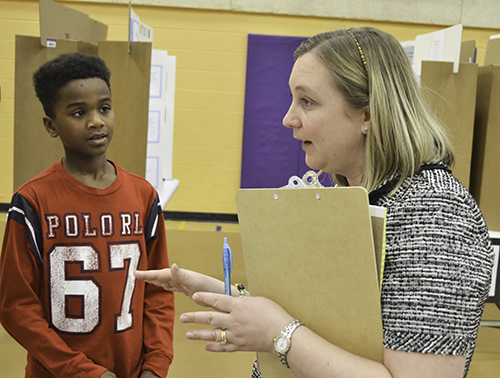
An NGS student listens as Angela Nelson (right), Director of NGS' after-school STEAM program, STEAM Studio, discusses his research project during the NGS Science and Engineering Fair.
February 19th, 2016 was probably circled in red on the calendars of many Next Generation School students (and most likely their parents’ calendars, too). After weeks spent choosing a project, learning about their subject in depth, designing and conducting a research project, then making a poster, the day of the school’s Science and Engineering Fair had finally arrived. Projects completed, the students were excited to finally get to present their research—first, to a local expert, who gave them positive, and possibly negative, feedback—then later, to mom and dad during the evening session open to the public.

An Illinois community expert listens as an NGS student discusses her research.
As in past years, no one student or team was declared the winner—all the students are winners. They’ve learned about the scientific method, gained in-depth knowledge about the subject matter of their project, plus acquired some useful skills about how to do and present research. The students also gained some other real-life skills that will be useful no matter what field they go into. For one, as in past years, the school invited community experts, many from Illinois, to help judge the projects, so students get an expert’s assessment of their project. So they’re put into a situation where they learn to think on their feet as they explain their work to someone they don’t know.
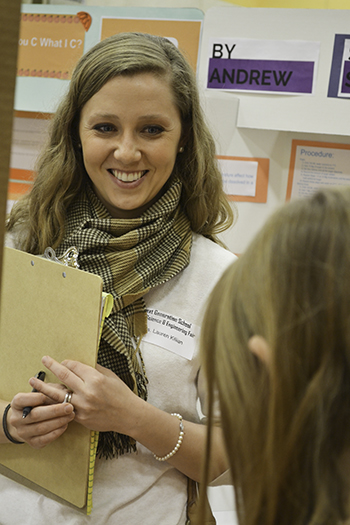
Illinois Division of Nutritional Sciences graduate student Lauren Killian interacts with an NGS student about her project.
Both Next Generation School staff, as well as the community experts, consider the benefits the students reap well worth everyone's time and effort. For instance, Head of the School Chris Bronowski says seeing her students’ excitement and watching them grow through the process are well worth the work involved.
“Watching what the students do and watching them push themselves,” acknowledges Bronowski, “it makes all of the preparation, all of the work that goes into it, every minute of it, worth it.”
Bronowski, whose daughter is in kindergarten this year, got to personally see first-hand the excitement the Fair generates in students.
“This morning, she was beside herself because they were going to have an expert coming to their room, and they were going to get to talk about their project,” She says. “Seeing that inspiration in her and that excitement, that’s why we do it.”
On the flipside of that, in addition to engendering excitement, she and her staff also hope to stir up some more negative feelings—like trepidation—so the students learn to overcome those.
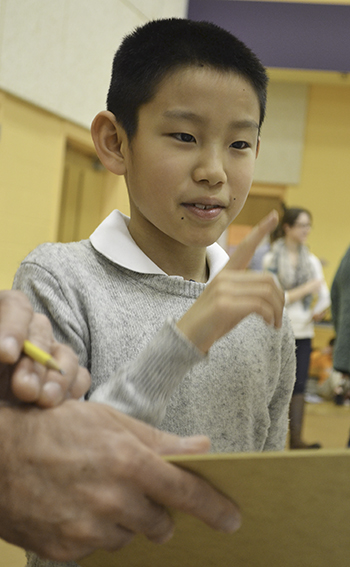
An NGS student presents his research.
“There were a lot of nervous kiddos coming in this morning, and that’s good,” she admits. “That’s good to put them in situations where they are nervous, and then they come together with these people who are wonderful, and they do it, and they see ‘Okay, well that wasn’t so bad’ and then the next time they do it, they’re not as nervous as the time before.”
In fact, the idea is that students should present to a total stranger. In the past, they have discouraged the recruitment of parents whose kids attend NGS to serve as judges, “because we really do want it to be someone whom the children are not familiar with,” says Bronowski. However, a number of last-minute cancellations this year forced them to call on parents who were STEM experts to serve as judges. However, these parents were cautioned during the orientation to not judge their child’s project, or even those of children that they know.
“Because we do want it to be a somewhat uncomfortable situation where they’re talking with someone that they don’t know,” acknowledges Bronowski.
What’s another negative emotion staff are ok with their students experiencing? The disappointment of failure. “They need to blow it sometimes,” adds Bronowski, “so that they see, ‘Okay, I can pick up the pieces and move on, and life doesn’t end.’ You do have to have those times where you do fail to see, ‘It’s all okay.’”
According to Bronowski, she and her staff had thought about introducing a theme to this year’s fair to give it more of a focus, but decided not to.
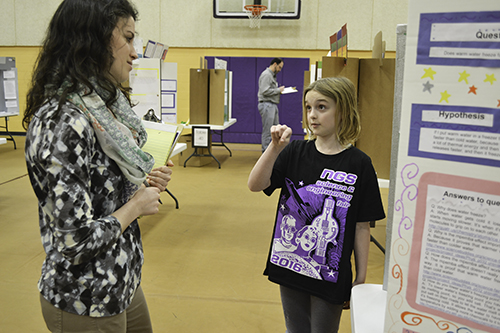
Illinois Molecular and Cellular Biology Ph.D. student, Mara Livesey (left), listens as an NGS student presents her research project during the NGS Science and Engineering Fair.
“I’m really glad that we didn’t,” she says, “because the variety in what the students have done this year and really watching them go with their passions and their interest is I think…I don’t know that we will ever consider that again after watching how they pick projects or ideas that are really suited for them. That’s what it’s all about: you follow your passion…We had two of our basketball players who designed a shoe. I think that ultimately we all kind of sat back and thought, “This is what it’s about.”
She says this year they did reintroduce middle schoolers working in partnerships, which she indicated worked well for them.
Like Bronowski, the community experts, most of whom are Illinois researchers or graduate students in STEM fields, take time from their work to serve as judges, many of them year after year, because they, too, enjoy the students’ excitement.
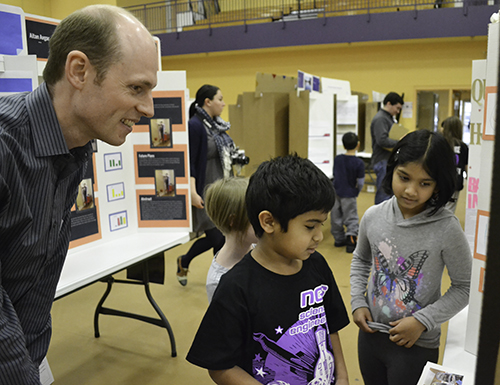
Illinois Assistant Professor Erik Nelson (top left), a cancer researcher in the Department of Molecular and Integrative Physiology, listens as an NGS student talks about their project.
Back serving as a judge for his second year in a row was Illinois Assistant Professor Erik Nelson. He enjoyed himself so much last year, that he signed up again.
“I was so impressed by the quality and the caliber of the science presented, and just the overall enthusiasm of the students was very contagious, so I really wanted to come back this year and learn about all the new great projects that are going on.”
Nelson believes participating in the Fair benefits the students in a couple of ways. For one, they learn about science:

An NGS student presents her research project to an Illinois researcher.
“This is a great way for the students to learn about the scientific method and learn about all the basic practices that real scientists do. They need to come up with a problem; they present a hypothesis; they come up with a mechanism to test that hypothesis; and then they go ahead and test it, and find their results.”
Like Bronowski, he also feels having students present their research is another key benefit:
“Today they have the opportunity to present the entire story from how they designed their projects to what their conclusions are, which in science is just as important as doing the work itself.”
Did Nelson see any future scientists or engineers? “Absolutely,” he reports. “I think every one of these students, at least all of the presentations that I’ve seen today, any one of those can be a potential scientist."
Another community expert who served as a judge, Henna Muzaffar, an Illinois researcher in Food Science and Human Nutrition, also believed many of the students could be future scientists. She cited one student’s project about battery lives. The student had examined three different kind of batteries used in hearing aids, and how air interacts with the content of the batteries when they’re not in use.
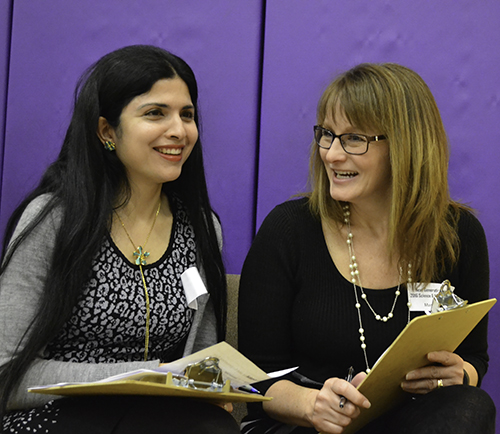
An Illinois researcher in Food Science and Human Nutrition, Henna Muzaffar (left), and another community expert, Mary Tucker, chat while filling out student evaluation forms.
“You can see that the depth of knowledge that the student has gained from this project is tremendous,” says Muzaffar, “and if she feels excited about learning this information, you can definitely see a scientist in her right there.”
Muzaffar has attended the NGS’ Science Fair for the last five years. “Every year it’s very exciting to come to the Science Fair and see all these kids come up with innovative ideas and great presentations. It’s a great learning experience for people of all ages.”
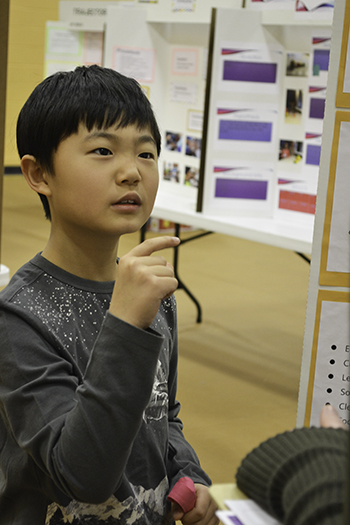
An NGS student presents his research project to a local expert.
This year Muzaffar actually got the opportunity to come and evaluate the students’ presentations: “I’m very impressed with the oral, the written, and the scientific skills that the students of Next Generation possess. I’m very, very impressed with all these kids. They are wonderful; they’ve done a tremendous amount of work in their projects, and it shows! They’re excited about the topic they explored, and they’ve put hours of work in preparing their presentations and doing the actual experiments, and then thinking about what future directions they can go from what they’ve learned from this present experiment.”
For Maxwell Baymiller, an Illinois biochemist, it was also his first year serving as a judge, and he too was quite impressed: “Yeah, I’ve been really pleasantly surprised. Some high-quality projects, especially in the young kids. I really like how they’ve encouraged them to create a clear question, address it with an experiment, and then get feedback on it rather than a win or a loss.
Baymiller says he, too, saw some future scientists: “There’s a couple of interesting biology projects. There was one kid who was very, very motivated about growing his funky organism. I’m actually about to recommend him to some different organization.”
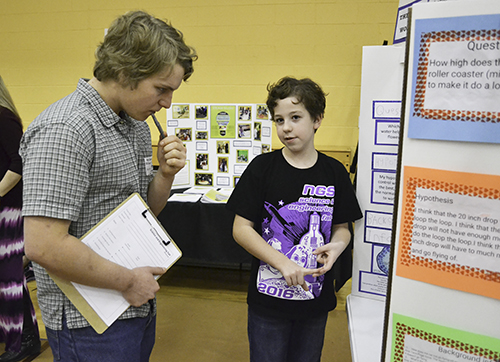
Illinois biochemist Maxwell Baymiller (left) judges a NextGen student's project.
Baymiller also appreciated the students’ creativity when choosing their projects: “One thing that was really interesting to me was that there were students who applied their science project to nontraditional areas. A great project just about baseball; the kid is into baseball, and it might have made him better at baseball by testing something about throwing. A girl who’s into Greek literature, who did a great social psychology experiment with it. You wouldn’t think that you could apply science to these things, but these kids managed.”
So, how did Head of School Chris Bronowski think the kids did? “They did so well,” shei asserts. “It’s not an easy process, and there were lots of “What do I do?” emails to Mr. Fritz on Saturday, especially at the middle school level. But ultimately, I feel like every one of our groups has come up with a really dynamic, interesting project that they should be proud of. We’re very proud of them for their effort and the thought that went behind it.”
More: 6-8 Outreach, K-6 Outreach, Next Generation School, Science Fair, 2016
For additional I-STEM articles highlighting Next Generation School's partnership with the University of Illinois, see the following:
- 2015 NGS Science & Engineering Fair Called the "Most Successful" Ever
- Next Generation School's Science and Engineering Fair: Every Student Is a Winner
- Next Generation School Fair: Tomorrow's Scientists & Engineers Meet Today's
- Local Teacher Uses Project Lead the Way to Prepare Next Generation of Engineers
- MechSE Gives Back to the Community
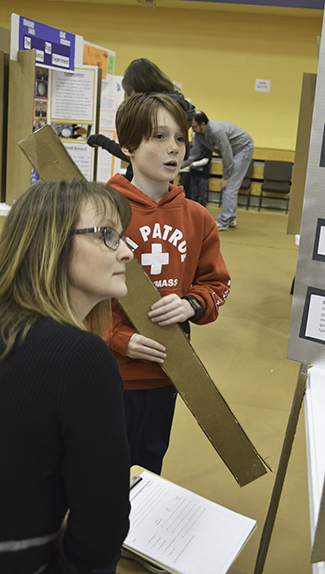
Community expert Mary Tucker (left) listens as an NGS student presents his research project.

An NGS student and her team present the results of their project about whether crushed seeds will grow.
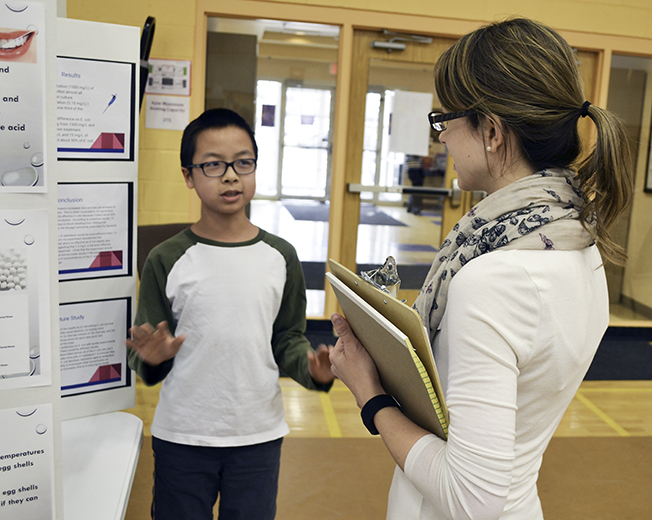
An NGS student discusses his research with an Illinois expert.













.jpg)
















